外研版(2019)选择性必修 第三册Unit 3 War and peace Developing ideas课件(共41张)
文档属性
| 名称 | 外研版(2019)选择性必修 第三册Unit 3 War and peace Developing ideas课件(共41张) | 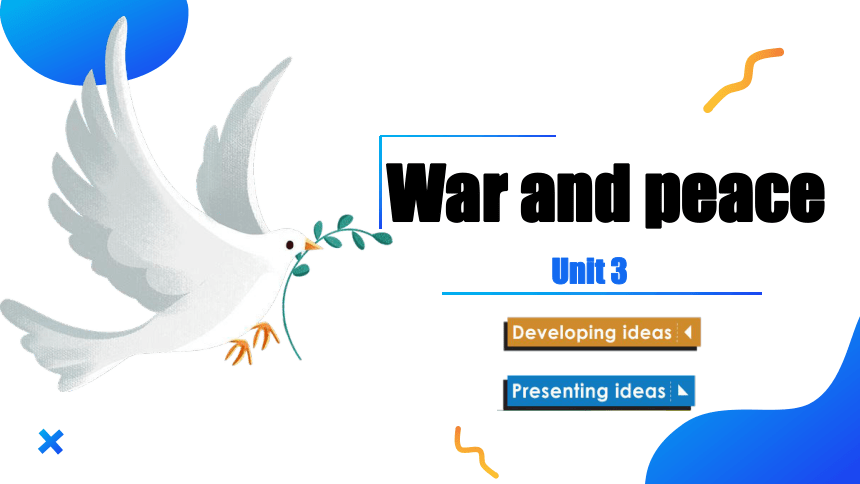 | |
| 格式 | pptx | ||
| 文件大小 | 8.4MB | ||
| 资源类型 | 教案 | ||
| 版本资源 | 外研版(2019) | ||
| 科目 | 英语 | ||
| 更新时间 | 2025-02-28 21:38:53 | ||
图片预览



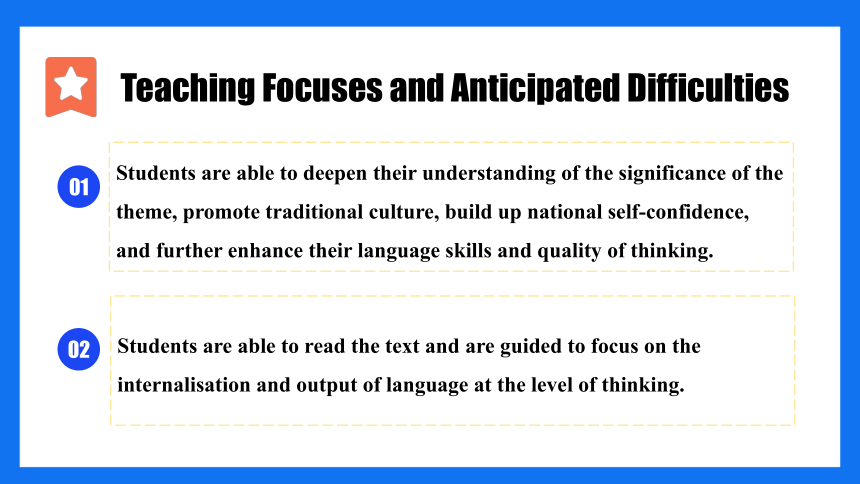
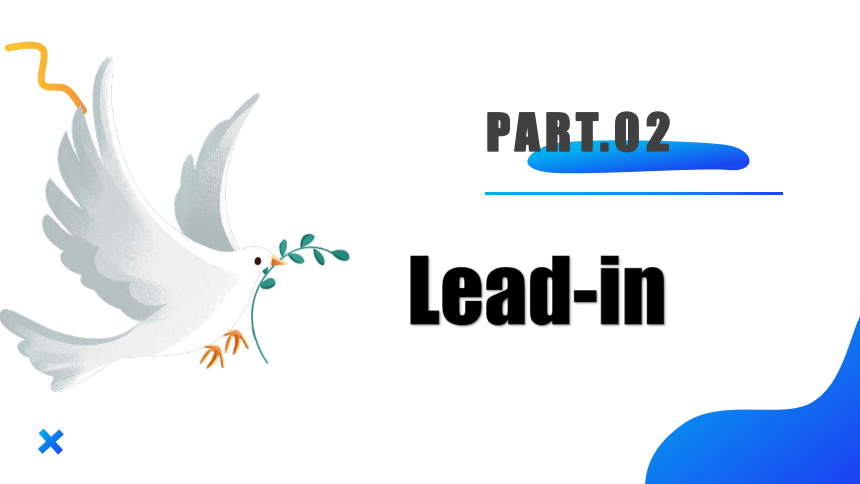

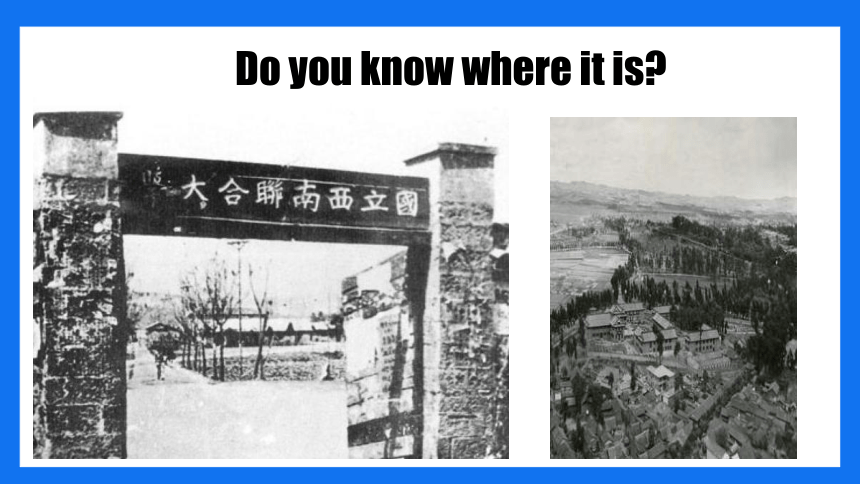
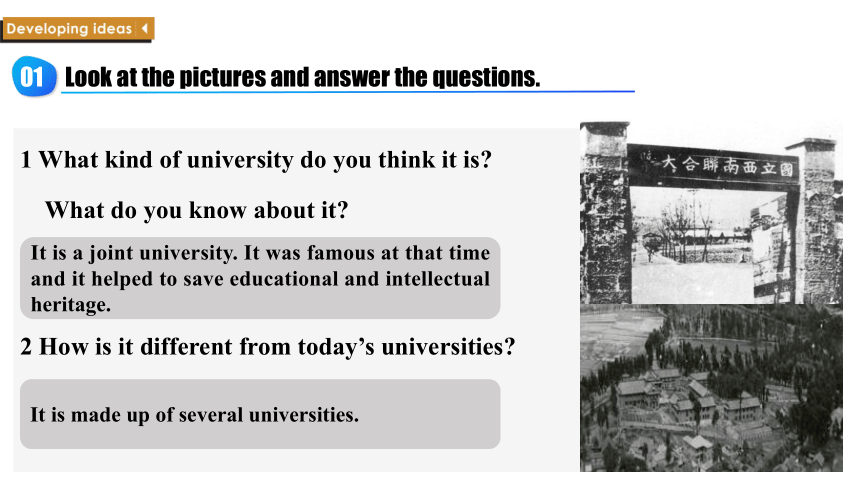
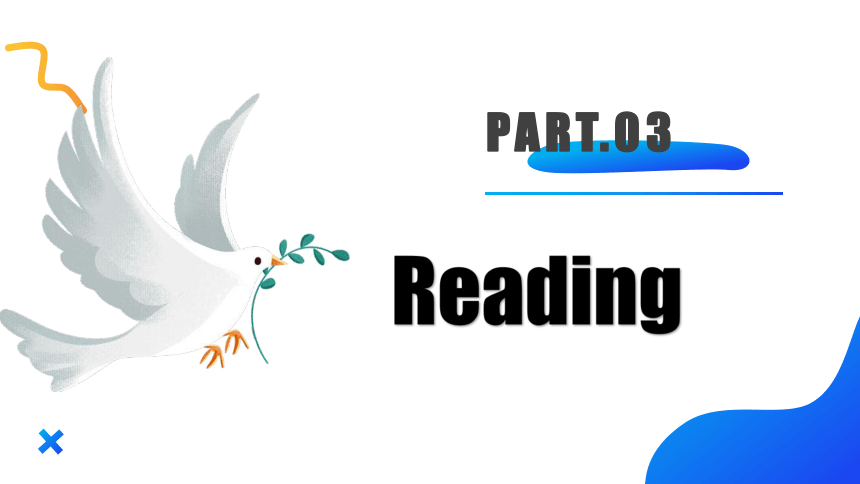

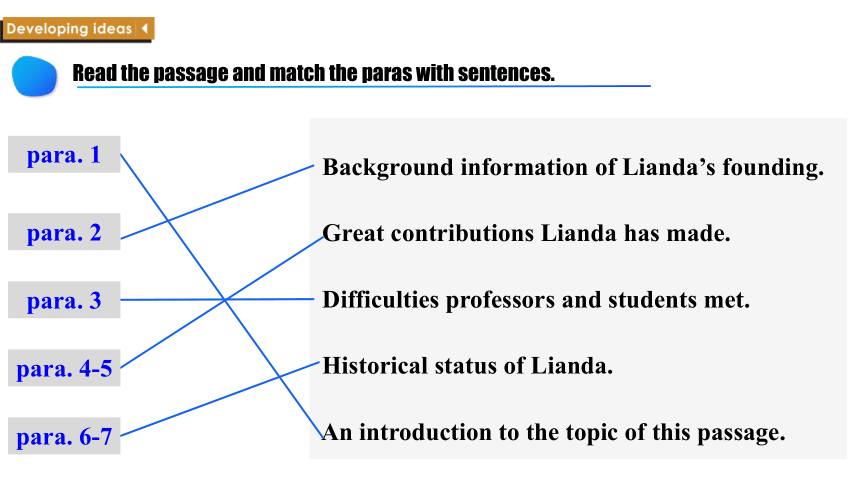

文档简介
(共41张PPT)
War and peace
Unit 3
PART.01
Learning Objectives
Grasp the key words and the phrases and get the genre and structure of the passage, and students can deepen their understanding of the meaning of the theme, and further improve their language skills and thinking quality.
01
Students are able to form an understanding of the cruelty of war, draw spiritual wealth from heroes and cultivate patriotism.
03
Students are able to understand the content of the text by reading it, and understand and use explicit and implicit metaphors to describe the distinctive features of things.
02
Learning Objectives
Students are able to deepen their understanding of the significance of the theme, promote traditional culture, build up national self-confidence, and further enhance their language skills and quality of thinking.
Students are able to read the text and are guided to focus on the internalisation and output of language at the level of thinking.
01
02
Teaching Focuses and Anticipated Difficulties
PART.02
Lead-in
What's your dream university
Do you know where it is
Look at the pictures and answer the questions.
01
1 What kind of university do you think it is
What do you know about it
2 How is it different from today’s universities
It is a joint university. It was famous at that time and it helped to save educational and intellectual heritage.
It is made up of several universities.
PART.03
Reading
Now read the passage and find out what is so special about Lianda.
LIANDA:
A PLACE OF PASSION,
BELIEF AND COMMITMENT
Background information of Lianda’s founding.
Great contributions Lianda has made.
Difficulties professors and students met.
Historical status of Lianda.
An introduction to the topic of this passage.
para. 1
para. 2
para. 3
para. 4-5
para. 6-7
Read the passage and match the paras with sentences.
Read the passage and answer the questions.
Why was Lianda founded
Throughout history, the great thinkers of the world have often rather romantically referred to their academic struggles as being like “war”. However, for most of them, the “war” has been purely symbolic. Real war is never romantic as it brings suffering and immense challenges.In 1937, the aggression of the Japanese army brought disaster to China’s three great universities: Peking University and Tsinghua University were occupied by Japanese troops, while Nankai University was completely destroyed by bombing. To save their educational and intellectual heritage, the three universities joined together in Kunming as National Southwest Associated University, otherwise known as Lianda.
To save educational and intellectual heritage.
Read the passage and answer the questions.
What is educational and intellectual heritage
Throughout history, the great thinkers of the world have often rather romantically referred to their academic struggles as being like “war”. However, for most of them, the “war” has been purely symbolic. Real war is never romantic as it brings suffering and immense challenges.In 1937, the aggression of the Japanese army brought disaster to China’s three great universities: Peking University and Tsinghua University were occupied by Japanese troops, while Nankai University was completely destroyed by bombing. To save their educational and intellectual heritage, the three universities joined together in Kunming as National Southwest Associated University, otherwise known as Lianda.
Books, equipment, students and scholars.
Read the passage and answer the questions.
Who did Lianda nurture
... It is no wonder that many, if not most, of China’s leading scholars and scientists emerged at Lianda, including the two Nobel Prize-winning physicists, Yang Zhenning and Li Zhengdao.” Lianda laid the foundation for every achievement I have made, ” Yang recalled. He still remembers learning in a temporary classroom that had no glass in the windows. “On windy days, we had to hold down the paper on the desk, which would otherwise be blown away, ” he said. With the country at war, students at Lianda were not going to shirk their duty. Driven by a sense of commitment, a great many joined the army to resist the Japanese invaders and defend the honour of the nation. In fact, Lianda provided the largest number of student-soldiers from any campus in China. Of the thousands of college students from all over China who served as interpreters, one tenth were from Lianda, including the well-known translators Zha Liangzheng and Xu Yuanchong. ...
Read the passage and answer the questions.
Who did Lianda nurture
1 Leading scholars and scientists, including two Nobel Prize-winning physicists, Yang Zhenning and Li Zhengdao.
2 The largest number of student-soldiers.
3 One tenth of interpreters, including the well-known translators Zha Lianzheng and Xu Yuanchong.
Read the passage and answer the questions.
What is the historical status of Lianda
A product of the war, Lianda is now physically gone. But it has become the crowning glory of China’s modern universities, not only because of its prominent professors and talented students, but also because of the school’s strong spirit of perseverance and dedication. In 2017, representatives from Peking University, Tsinghua University, Nankai University and Yunnan Normal University gathered to commemorate the 80th anniversary of its founding.
More than eighty years on, the priceless contribution of Lianda still needs to be reaffirmed. It has become part of the collective memory of the Chinese nation, with its spirit as the blueprint for all universities in China in the modern era.
Choose the ideas that are conveyed in the passage. Find evidence to support your choices.
02
1 Lianda was the best university in Chinese history.
2 The story of Lianda shows Chinese intellectuals’ academic pursuit and patriotism.
3 Only under difficult circumstances can students succeed.
4 Lianda has nurtured many outstanding scholars.
5 Lianda was a great success only because it had prominent professors and talented students.
6 People today still admire the spirit of Lianda.
Academic pursuit:
However,despite the immense hardships and the daunting challenges,it was right in this place, over a period of eight long years,that the nation’s intellectual heritage was not only guarded but fortified by the passion and belief of the worthy academics of Lianda.
Patriotism:
With the country at war, students at Lianda were not going to shirk their duty. Driven by a sense of commitment,a great many joined the army to resist the Japanese invaders and defend the honour of the nation. In fact,Lianda provided the largest number of student-soldiers from any campus in China. Of the thousands of college students from all over China who served as interpreters,one tenth were from Lianda,including the well-known translators Zha Liangzheng and Xu Yuanchong.
Choose the ideas that are conveyed in the passage. Find evidence to support your choices.
02
1 Lianda was the best university in Chinese history.
2 The story of Lianda shows Chinese intellectuals’ academic pursuit and patriotism.
3 Only under difficult circumstances can students succeed.
4 Lianda has nurtured many outstanding scholars.
5 Lianda was a great success only because it had prominent professors and talented students.
6 People today still admire the spirit of Lianda.
Lianda has nurtured many outstanding scholars.
...including the two Nobel Prize-winning physicists,Yang Zhenning and Li Zhengdao.
People today still admire the spirit of Lianda.
More than eighty years on,the priceless contribution of Lianda still needs to be reaffirmed. It has become part of the collective memory of the Chinese nation,with its spirit as the blueprint for all universities in China in the modern era.
Find out what figures of speech are used in the sentences and discuss how they
help to express the author’s emotions.
03
1 Their bed was the dusty road and their roof was the open sky, ...
2 They had to live in rough buildings, packed 40 to a room, like sardines.
metaphor
simile
Learning to learn
Similes and metaphors are two commonly used, but easy to confuse, figures of speech. Similes compare and show similarities in typically different things. Similes usually use connecting words such as like, as, so and resemble. For example, He is as cool as a cucumber. Unlike similes, metaphors make direct comparisons without using connecting words. For example, She has a heart of a lion.
1 What difficulties did the professors and students of Lianda encounter
How did they deal with these
2 What is your understanding of the poem written by Zha Liangzheng
Think & Share
Talk with your partner.
They had to travel a long distance to reach Lianda. Throughout the journey, they had no accommodation and had to survive extreme conditions. Also, the conditions in Lianda itself were very harsh. They did not have enough food and studied in rough buildings. Furthermore, their study was often interrupted by air attacks. They had to adapt to these challenges, for instance, by holding their classes when they were not likely to be bombed.
3 What contribution did Lianda make to the education of the nation
4 In what ways is the theme of war and peace presented differently in the two reading passages in this unit
Think & Share
Many of China’s leading scholars and scientists came from Lianda, including two Nobel Prize winners. Lianda’s spirit has become the blueprint for all universities in China in the modern era.
The passage on the D-Day landings focuses on war as a military operation, and on how dead soldiers are memorialised. The passage on Lianda focuses on how war affected China’s students and academics, and how they were able to achieve excellence in spite of the great difficulties.
an academic career 学术生涯
academic subjects/qualifcations 学科/学历
the start ofthe new academic year 新学年的开始
academic performance 学习成绩
练习:
The students return in September for the start of __________________ (新学年).
the new academic year
1. academic
emergence n.出现;显现
emergency n.紧急情况,不测事件
in an emergency 在紧急情况下
in case ofemergency 万一遇到紧急情况
练习: 在紧急情况下,分秒必争。
__________________________________________
Every minute counts in an emergency.
2. emerge
hold on 等会儿;别挂断电话;坚持下去
hold on to 守住,保住;紧紧抓住
hold back 阻挡;控制;隐瞒
hold out 伸出(手):维持,坚持
hold up 举起,支撑;耽搁,阻碍
hold together (使)团结,(使)不分裂
练习:
No one can hold ____________ the wheel of history.
back
3. hold down
be representative of 代表……的
are presentative of the UN 联合国代表
represent v.代表;表示,象征;描绘,展示
representation n.代表,代理;描绘,表现
练习: 这幅画不是他在那个时期的代表作。
_______________________________________________
The painting is not representative of his work of the period.
4. representative
break into 闯入;突然……起来
break in 破门而入;打断谈话
break out 突然发生,爆发
break off 停顿;断绝;(使)脱落
break down 出故障;失败;分解
练习:
They had escaped to America before the war broke ______________.
out
5. break through
It is no wonder (that)..……不足为奇,难怪…
It is no wonder that you've achieved so great success.
难怪你取得了这么大的成功。
No wonder(that)...=It is no wonder(that)...难怪…
It is a wonder (that)...令人惊奇的是……
No wonder that she misunderstood him. His spoken English is poor.
难怪她误会了他,他的英语口语很差。
6. It is no wonder (that)..…
PART.04
Writing
Work in groups. Give a talk about the spirit of Lianda.
04
1 Discuss the questions below.
How can you describe the spirit of Lianda
What examples support your ideas
What can you learn from the story of Lianda
2 Complete the diagram with your ideas and the examples that support them.
3 Give your talk to the class.
Lianda Spirit:_______ Supporting evidence:___
Spirit:_______ Supporting evidence:___
... Read the introduction to Yang Jingyu and answer the questions.
05
1 Who was Yang Jingyu
2 Why did Yang decide to let small groups of his men break through the encirclement
3 What did the Japanese find when they killed Yang
4 How would you describe Yang’s spirit in your own words
Yang Jingyu was an anti-Japanese hero, who died in a fight against Japanese troops.
Because at that time there was a critical lack of supplies.
They found only tree bark, cotton and grass roots, instead of rice in his stomach.
Work in groups.
06
Talk about other war heroes and choose one to write about. Organise your ideas by completing the notes below. Do more research if necessary.
Introduction Main body Conclusion
Name of the person: ________________ Background information: __________________________________ Major events (in order): ____________________________________________________________________________________________________ Your opinion of this person:
___________________________________________________________________________________________________________________
Dong Cunrui was born into a poor peasant family in Huailai County, Hebei Province on 15 October 1929. In 1945 he joined the Eighth Route Army and in March 1947 he joined the Communist Party of China.
On 25 May 1948, the battle for the liberation of Longhua began, and the soldiers of the Chinese People’s Liberation Army (PLA) flooded towards Longhua Middle School, the headquarters of the enemy. Six jets of fire from a bridge blocked the path of the PLA troops. The bridge was a fortress built by the enemy, and the PLA troops were stuck under a small slope. At the critical moment, they needed a soldier to blow up the bridge and open a new road for the whole army. “Captain, let me blow it up!”
Sample
Dong Cunrui said, and his request was granted. Under the cover of another soldier, he rushed to the bridge, but could not find a place to put the explosives. Dong Cunrui then lifted the explosives in his left hand, lit the blasting fuse and blew up the enemy's fortress. In doing so, he died a hero.
The story of Dong Cunrui, who gave his life to create a way forward, has been told all over China until today, and has inspired thousands of young people to make sacrifices in defence of our country’s and people’s interests.
Sample
Work in groups. Look at the pictures and answer the questions.
01
1 What can you see in each picture
2 What do the pictures tell you about war
In picture one, a distressed child is crying in front of a destroyed building. In picture two, a dead or injured soldier is carried away by his comrades. In picture three, there are many graves of the dead.
Think about the topics and complete the table. Add examples or details to support your points. Do more research if necessary.
02
Why people go to war
Effects of war on people
How we can maintain peace around the world
Work in group.
03
Prepare a short presentation on one of the topics from Activity 2 or think of another relevant topic. Consider the following:
1 the structure of your presentation
2 useful words, expressions and structures
Give your presentation to the class.
PART.05
Exercise
Exercise 用所给短语的适当形式填空
light up, serve as, a sum of, at war, break through, blow away, track down
1.On September 5,at the end of the festival,a huge display of fireworks will the sky around the whole area.
2.In some countries,smartphones and other mobile devices___ replacements for the traditional desktop computer.
3.Strong winds can also the valuable soil that lies on the top of the fields.
4.The sun at around lunchtime after several cloudy days.
5.Our nation is ___ against a far-reaching network of violence and hate.
6.They presented ____ money to the school where they studied years ago.
7.I don’t know where that old story came from.I’ve never been able to ___ it ___ .
light up
serve as
blow away
blow away
broke through
at war
track
down
6.I have saved a (金额) of money with which to buy a new computer for myself.
1.The firm has two (代表) in every European city.
2.Farmers produced millions of tons of (谷物) to feed the nation.
3.The test was to judge ability rather than a success.
4.The new moon (出现) from behind the clouds.
5.A 100-pound b went off today,injuring three people.
Exercise
representatives
grain
academic
emerged
bomb
sum
PART.06
Homework
Homework
1. Finish you composition; summarise what we have learnt in this lesson;
2. prepare for the next lesson.
War and peace
Unit 3
PART.01
Learning Objectives
Grasp the key words and the phrases and get the genre and structure of the passage, and students can deepen their understanding of the meaning of the theme, and further improve their language skills and thinking quality.
01
Students are able to form an understanding of the cruelty of war, draw spiritual wealth from heroes and cultivate patriotism.
03
Students are able to understand the content of the text by reading it, and understand and use explicit and implicit metaphors to describe the distinctive features of things.
02
Learning Objectives
Students are able to deepen their understanding of the significance of the theme, promote traditional culture, build up national self-confidence, and further enhance their language skills and quality of thinking.
Students are able to read the text and are guided to focus on the internalisation and output of language at the level of thinking.
01
02
Teaching Focuses and Anticipated Difficulties
PART.02
Lead-in
What's your dream university
Do you know where it is
Look at the pictures and answer the questions.
01
1 What kind of university do you think it is
What do you know about it
2 How is it different from today’s universities
It is a joint university. It was famous at that time and it helped to save educational and intellectual heritage.
It is made up of several universities.
PART.03
Reading
Now read the passage and find out what is so special about Lianda.
LIANDA:
A PLACE OF PASSION,
BELIEF AND COMMITMENT
Background information of Lianda’s founding.
Great contributions Lianda has made.
Difficulties professors and students met.
Historical status of Lianda.
An introduction to the topic of this passage.
para. 1
para. 2
para. 3
para. 4-5
para. 6-7
Read the passage and match the paras with sentences.
Read the passage and answer the questions.
Why was Lianda founded
Throughout history, the great thinkers of the world have often rather romantically referred to their academic struggles as being like “war”. However, for most of them, the “war” has been purely symbolic. Real war is never romantic as it brings suffering and immense challenges.In 1937, the aggression of the Japanese army brought disaster to China’s three great universities: Peking University and Tsinghua University were occupied by Japanese troops, while Nankai University was completely destroyed by bombing. To save their educational and intellectual heritage, the three universities joined together in Kunming as National Southwest Associated University, otherwise known as Lianda.
To save educational and intellectual heritage.
Read the passage and answer the questions.
What is educational and intellectual heritage
Throughout history, the great thinkers of the world have often rather romantically referred to their academic struggles as being like “war”. However, for most of them, the “war” has been purely symbolic. Real war is never romantic as it brings suffering and immense challenges.In 1937, the aggression of the Japanese army brought disaster to China’s three great universities: Peking University and Tsinghua University were occupied by Japanese troops, while Nankai University was completely destroyed by bombing. To save their educational and intellectual heritage, the three universities joined together in Kunming as National Southwest Associated University, otherwise known as Lianda.
Books, equipment, students and scholars.
Read the passage and answer the questions.
Who did Lianda nurture
... It is no wonder that many, if not most, of China’s leading scholars and scientists emerged at Lianda, including the two Nobel Prize-winning physicists, Yang Zhenning and Li Zhengdao.” Lianda laid the foundation for every achievement I have made, ” Yang recalled. He still remembers learning in a temporary classroom that had no glass in the windows. “On windy days, we had to hold down the paper on the desk, which would otherwise be blown away, ” he said. With the country at war, students at Lianda were not going to shirk their duty. Driven by a sense of commitment, a great many joined the army to resist the Japanese invaders and defend the honour of the nation. In fact, Lianda provided the largest number of student-soldiers from any campus in China. Of the thousands of college students from all over China who served as interpreters, one tenth were from Lianda, including the well-known translators Zha Liangzheng and Xu Yuanchong. ...
Read the passage and answer the questions.
Who did Lianda nurture
1 Leading scholars and scientists, including two Nobel Prize-winning physicists, Yang Zhenning and Li Zhengdao.
2 The largest number of student-soldiers.
3 One tenth of interpreters, including the well-known translators Zha Lianzheng and Xu Yuanchong.
Read the passage and answer the questions.
What is the historical status of Lianda
A product of the war, Lianda is now physically gone. But it has become the crowning glory of China’s modern universities, not only because of its prominent professors and talented students, but also because of the school’s strong spirit of perseverance and dedication. In 2017, representatives from Peking University, Tsinghua University, Nankai University and Yunnan Normal University gathered to commemorate the 80th anniversary of its founding.
More than eighty years on, the priceless contribution of Lianda still needs to be reaffirmed. It has become part of the collective memory of the Chinese nation, with its spirit as the blueprint for all universities in China in the modern era.
Choose the ideas that are conveyed in the passage. Find evidence to support your choices.
02
1 Lianda was the best university in Chinese history.
2 The story of Lianda shows Chinese intellectuals’ academic pursuit and patriotism.
3 Only under difficult circumstances can students succeed.
4 Lianda has nurtured many outstanding scholars.
5 Lianda was a great success only because it had prominent professors and talented students.
6 People today still admire the spirit of Lianda.
Academic pursuit:
However,despite the immense hardships and the daunting challenges,it was right in this place, over a period of eight long years,that the nation’s intellectual heritage was not only guarded but fortified by the passion and belief of the worthy academics of Lianda.
Patriotism:
With the country at war, students at Lianda were not going to shirk their duty. Driven by a sense of commitment,a great many joined the army to resist the Japanese invaders and defend the honour of the nation. In fact,Lianda provided the largest number of student-soldiers from any campus in China. Of the thousands of college students from all over China who served as interpreters,one tenth were from Lianda,including the well-known translators Zha Liangzheng and Xu Yuanchong.
Choose the ideas that are conveyed in the passage. Find evidence to support your choices.
02
1 Lianda was the best university in Chinese history.
2 The story of Lianda shows Chinese intellectuals’ academic pursuit and patriotism.
3 Only under difficult circumstances can students succeed.
4 Lianda has nurtured many outstanding scholars.
5 Lianda was a great success only because it had prominent professors and talented students.
6 People today still admire the spirit of Lianda.
Lianda has nurtured many outstanding scholars.
...including the two Nobel Prize-winning physicists,Yang Zhenning and Li Zhengdao.
People today still admire the spirit of Lianda.
More than eighty years on,the priceless contribution of Lianda still needs to be reaffirmed. It has become part of the collective memory of the Chinese nation,with its spirit as the blueprint for all universities in China in the modern era.
Find out what figures of speech are used in the sentences and discuss how they
help to express the author’s emotions.
03
1 Their bed was the dusty road and their roof was the open sky, ...
2 They had to live in rough buildings, packed 40 to a room, like sardines.
metaphor
simile
Learning to learn
Similes and metaphors are two commonly used, but easy to confuse, figures of speech. Similes compare and show similarities in typically different things. Similes usually use connecting words such as like, as, so and resemble. For example, He is as cool as a cucumber. Unlike similes, metaphors make direct comparisons without using connecting words. For example, She has a heart of a lion.
1 What difficulties did the professors and students of Lianda encounter
How did they deal with these
2 What is your understanding of the poem written by Zha Liangzheng
Think & Share
Talk with your partner.
They had to travel a long distance to reach Lianda. Throughout the journey, they had no accommodation and had to survive extreme conditions. Also, the conditions in Lianda itself were very harsh. They did not have enough food and studied in rough buildings. Furthermore, their study was often interrupted by air attacks. They had to adapt to these challenges, for instance, by holding their classes when they were not likely to be bombed.
3 What contribution did Lianda make to the education of the nation
4 In what ways is the theme of war and peace presented differently in the two reading passages in this unit
Think & Share
Many of China’s leading scholars and scientists came from Lianda, including two Nobel Prize winners. Lianda’s spirit has become the blueprint for all universities in China in the modern era.
The passage on the D-Day landings focuses on war as a military operation, and on how dead soldiers are memorialised. The passage on Lianda focuses on how war affected China’s students and academics, and how they were able to achieve excellence in spite of the great difficulties.
an academic career 学术生涯
academic subjects/qualifcations 学科/学历
the start ofthe new academic year 新学年的开始
academic performance 学习成绩
练习:
The students return in September for the start of __________________ (新学年).
the new academic year
1. academic
emergence n.出现;显现
emergency n.紧急情况,不测事件
in an emergency 在紧急情况下
in case ofemergency 万一遇到紧急情况
练习: 在紧急情况下,分秒必争。
__________________________________________
Every minute counts in an emergency.
2. emerge
hold on 等会儿;别挂断电话;坚持下去
hold on to 守住,保住;紧紧抓住
hold back 阻挡;控制;隐瞒
hold out 伸出(手):维持,坚持
hold up 举起,支撑;耽搁,阻碍
hold together (使)团结,(使)不分裂
练习:
No one can hold ____________ the wheel of history.
back
3. hold down
be representative of 代表……的
are presentative of the UN 联合国代表
represent v.代表;表示,象征;描绘,展示
representation n.代表,代理;描绘,表现
练习: 这幅画不是他在那个时期的代表作。
_______________________________________________
The painting is not representative of his work of the period.
4. representative
break into 闯入;突然……起来
break in 破门而入;打断谈话
break out 突然发生,爆发
break off 停顿;断绝;(使)脱落
break down 出故障;失败;分解
练习:
They had escaped to America before the war broke ______________.
out
5. break through
It is no wonder (that)..……不足为奇,难怪…
It is no wonder that you've achieved so great success.
难怪你取得了这么大的成功。
No wonder(that)...=It is no wonder(that)...难怪…
It is a wonder (that)...令人惊奇的是……
No wonder that she misunderstood him. His spoken English is poor.
难怪她误会了他,他的英语口语很差。
6. It is no wonder (that)..…
PART.04
Writing
Work in groups. Give a talk about the spirit of Lianda.
04
1 Discuss the questions below.
How can you describe the spirit of Lianda
What examples support your ideas
What can you learn from the story of Lianda
2 Complete the diagram with your ideas and the examples that support them.
3 Give your talk to the class.
Lianda Spirit:_______ Supporting evidence:___
Spirit:_______ Supporting evidence:___
... Read the introduction to Yang Jingyu and answer the questions.
05
1 Who was Yang Jingyu
2 Why did Yang decide to let small groups of his men break through the encirclement
3 What did the Japanese find when they killed Yang
4 How would you describe Yang’s spirit in your own words
Yang Jingyu was an anti-Japanese hero, who died in a fight against Japanese troops.
Because at that time there was a critical lack of supplies.
They found only tree bark, cotton and grass roots, instead of rice in his stomach.
Work in groups.
06
Talk about other war heroes and choose one to write about. Organise your ideas by completing the notes below. Do more research if necessary.
Introduction Main body Conclusion
Name of the person: ________________ Background information: __________________________________ Major events (in order): ____________________________________________________________________________________________________ Your opinion of this person:
___________________________________________________________________________________________________________________
Dong Cunrui was born into a poor peasant family in Huailai County, Hebei Province on 15 October 1929. In 1945 he joined the Eighth Route Army and in March 1947 he joined the Communist Party of China.
On 25 May 1948, the battle for the liberation of Longhua began, and the soldiers of the Chinese People’s Liberation Army (PLA) flooded towards Longhua Middle School, the headquarters of the enemy. Six jets of fire from a bridge blocked the path of the PLA troops. The bridge was a fortress built by the enemy, and the PLA troops were stuck under a small slope. At the critical moment, they needed a soldier to blow up the bridge and open a new road for the whole army. “Captain, let me blow it up!”
Sample
Dong Cunrui said, and his request was granted. Under the cover of another soldier, he rushed to the bridge, but could not find a place to put the explosives. Dong Cunrui then lifted the explosives in his left hand, lit the blasting fuse and blew up the enemy's fortress. In doing so, he died a hero.
The story of Dong Cunrui, who gave his life to create a way forward, has been told all over China until today, and has inspired thousands of young people to make sacrifices in defence of our country’s and people’s interests.
Sample
Work in groups. Look at the pictures and answer the questions.
01
1 What can you see in each picture
2 What do the pictures tell you about war
In picture one, a distressed child is crying in front of a destroyed building. In picture two, a dead or injured soldier is carried away by his comrades. In picture three, there are many graves of the dead.
Think about the topics and complete the table. Add examples or details to support your points. Do more research if necessary.
02
Why people go to war
Effects of war on people
How we can maintain peace around the world
Work in group.
03
Prepare a short presentation on one of the topics from Activity 2 or think of another relevant topic. Consider the following:
1 the structure of your presentation
2 useful words, expressions and structures
Give your presentation to the class.
PART.05
Exercise
Exercise 用所给短语的适当形式填空
light up, serve as, a sum of, at war, break through, blow away, track down
1.On September 5,at the end of the festival,a huge display of fireworks will the sky around the whole area.
2.In some countries,smartphones and other mobile devices___ replacements for the traditional desktop computer.
3.Strong winds can also the valuable soil that lies on the top of the fields.
4.The sun at around lunchtime after several cloudy days.
5.Our nation is ___ against a far-reaching network of violence and hate.
6.They presented ____ money to the school where they studied years ago.
7.I don’t know where that old story came from.I’ve never been able to ___ it ___ .
light up
serve as
blow away
blow away
broke through
at war
track
down
6.I have saved a (金额) of money with which to buy a new computer for myself.
1.The firm has two (代表) in every European city.
2.Farmers produced millions of tons of (谷物) to feed the nation.
3.The test was to judge ability rather than a success.
4.The new moon (出现) from behind the clouds.
5.A 100-pound b went off today,injuring three people.
Exercise
representatives
grain
academic
emerged
bomb
sum
PART.06
Homework
Homework
1. Finish you composition; summarise what we have learnt in this lesson;
2. prepare for the next lesson.
